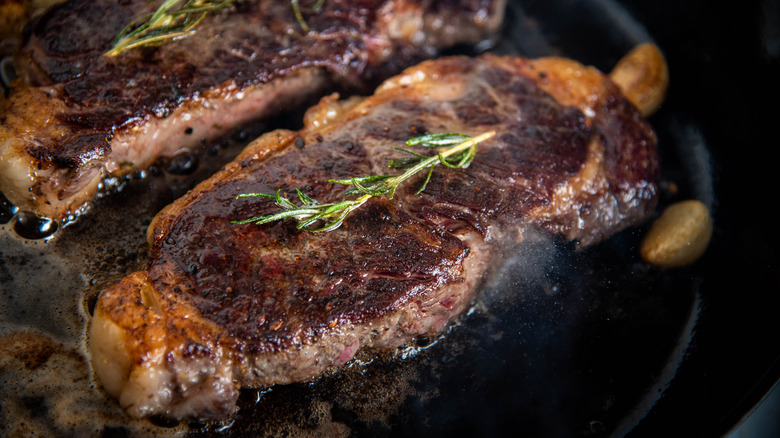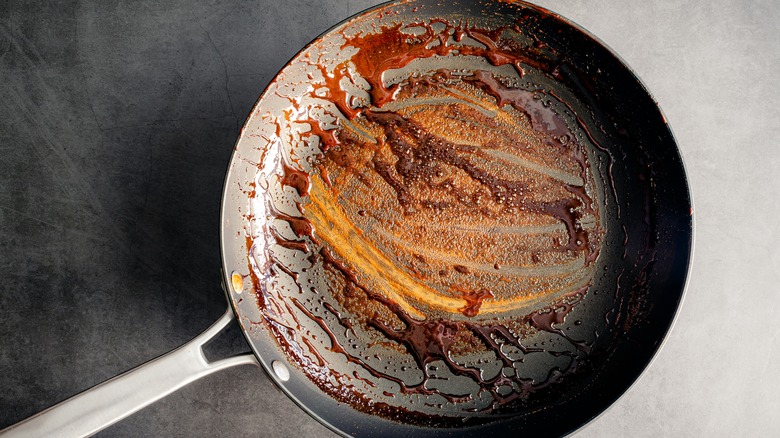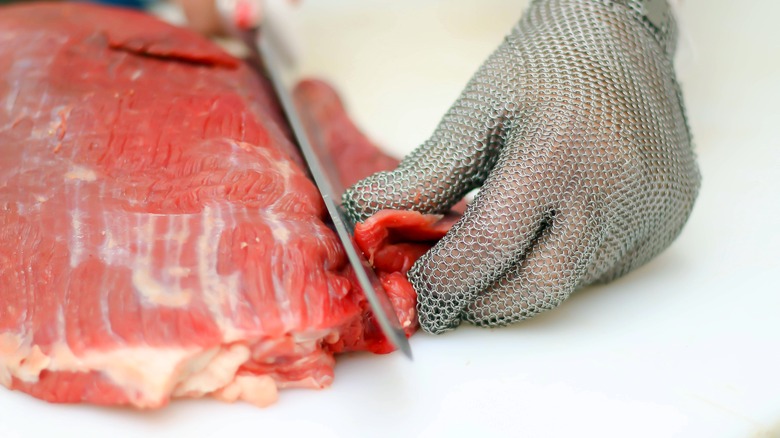Create More Fond In Your Pot Using A Simple Water Trick
Usually, when you brown meat, you want everything super dry; that has traditionally been the advice for how you get a good crust through searing. But if your real goal is to create more fond — brace yourself — you may actually want to add water to your pan.
Fond is the layer of browned bits and residue that all deglazing pros know is the secret weapon for flavor. It's the basis of braises and pan sauces. The more fond you accumulate, the more flavorful your sauce will be. The secret to creating more fond is to simmer the meat in a little water; this coaxes out more juices, allowing them to brown on the bottom of the pan. Tests by Cooked Illustrated show that this technique is highly effective in increasing the amount of fond in the bottom of your pan by drawing more juices and fat out of the meat.
Of course, there are few instances when you'll want to simmer the meat headed for your dinner plate. Instead, consider this an opportunity to use what would otherwise be considered food waste: the trimmings. After searing your cut of meat, remove it from the pan and let it rest. Add in your diced-up trimmings and a bit of water, and let it simmer until the water evaporates. Remove the bits and you'll be left with plenty of fond to deglaze into an incredibly flavorful dish. It gives a whole new, tasty meaning to reduce, reuse, and recycle.
Why does this work?
This next part won't sound as appetizing, but hang in there: Fond is simply browned meat residue. The Maillard Reaction, the browning effect every cook should know, happens when amino acid protein molecules and sugar molecules interact at temperatures above water's boiling point. When searing a cut of meat, this happens on the surface of the meat. For this to happen in the pan, you must draw out the meat's juices and then let enough water evaporate so the proteins and sugar left in the residue begin to brown. The more juices you can draw out, the more fond there will be.
This simmering trick is all about coaxing those juices out of the meat — and, although it hasn't been thoroughly studied by science yet, we can draw some educated conclusions about why it works so well from studies that have been done. A paper on ResearchGate shows that meat loses moisture rapidly in two stages: The intramyofibrillar moisture (inside the muscle fibers) oozes out once the meat's internal temperature reaches 104 degrees Fahrenheit, while the extramyofibrillar (the tissue outside the fibers) moisture releases at temperatures over 154 degrees. Another study on Meat and Muscle Biology says the presence of exterior moisture speeds up cooking substantially, drawing out protein and collagen. So, simmering trimmings in water helps to draw out those proteins from deep within the meat but stabilizes the temperature in the pan, keeping the fond from burning before all the juices are extracted.
Why it's important to use meat trimmings
The reason you want to use trimmings instead of the meat you plan to eat is the same reason you don't want to overcrowd your pan while you're browning: It will make your meat dry and tough. Anyone who has had boiled meat knows this all too well. It's just not great for eating, and no amount of delicious pan sauce will fix it.
You're never going to get a good cook on your meat if you simmer it in water first. The interior will be overcooked, and the exterior won't form a crust. The study published on Meat and Muscle Biology – about the effect of high humidity in cooking — found that a lot of water in the cooking process leaves meat, particularly beef, with a metallic and bloody taste. You really don't want to simmer the meat you plan to eat in the name of creating more fond in your pan.
Instead, trimmings are the answer. The bits of meat, tendons, and fat that you don't want to eat are perfect for simmering until they're completely depleted, using up the scraps that would otherwise go to waste to create a solid layer of fond in the bottom of your pan.


